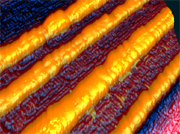 Nanosensors are arrays of wires that can capture and detect a single molecule, which would made them excellent bomb sniffers. Nanosensors exist, technically, but they’re extremely difficult to manufacture and extremely delicate. However, thanks to a new technique created by HP, scientists have been able to make nanosensors as quickly but not quite as easily as they would make a standard circuit board.
Nanosensors are arrays of wires that can capture and detect a single molecule, which would made them excellent bomb sniffers. Nanosensors exist, technically, but they’re extremely difficult to manufacture and extremely delicate. However, thanks to a new technique created by HP, scientists have been able to make nanosensors as quickly but not quite as easily as they would make a standard circuit board.
According to one of the researchers, Regina Ragan (formerly with HP and now a professor of chemical engineering at UC Irvine), at some concentrations of platinum, the metal seems to form clumps, leaving parts of the wire uncoated. After the researchers exposed the nanowires to plasma, the uncovered parts of the wires were etched away, leaving tightly spaced platinum nanoparticles each about eight nanometers across. The technique could be easy and inexpensive to scale up because it uses common commercial techniques for deposition and etching, and requires few steps, Ragan says.
This is very similar to the techniques used to etch silicon chips and is much easier to use than the current methods which require multiple steps and are not foolproof. Pretty high tech, but it looks like we’re headed in the right direction.
A New Way to Make Ultrasensitive Explosives Detectors [TechnologyReview]